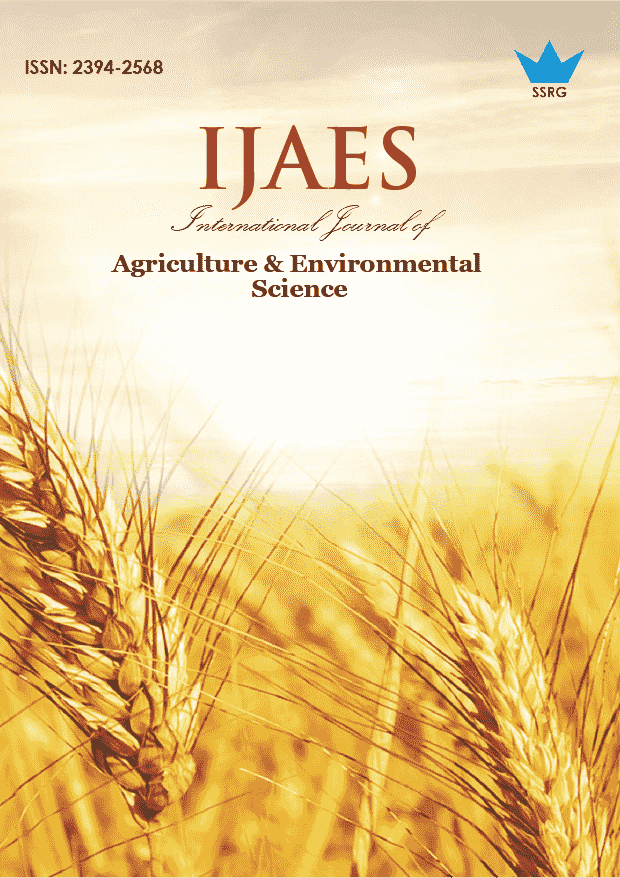Impact of Climate Change and Adaptations in Clove Farming in Pemba Island, Zanzibar, Tanzania

| International Journal of Agriculture & Environmental Science |
| © 2025 by SSRG - IJAES Journal |
| Volume 12 Issue 3 |
| Year of Publication : 2025 |
| Authors : Fatma Masoud Ali, Mary Mtumwa Khatib, Yussuf Abdul Rahim Yussuf, Abdalla Ibrahim Ali |
How to Cite?
Fatma Masoud Ali, Mary Mtumwa Khatib, Yussuf Abdul Rahim Yussuf, Abdalla Ibrahim Ali, "Impact of Climate Change and Adaptations in Clove Farming in Pemba Island, Zanzibar, Tanzania," SSRG International Journal of Agriculture & Environmental Science, vol. 12, no. 3, pp. 9-13, 2025. Crossref, https://doi.org/10.14445/23942568/IJAES-V12I3P102
Abstract:
Clove farming is highly impacted by climate change, specifically changes in rainfall and temperature. The study evaluated how cloves farming is affected by climate change and the adaptation approaches farmers have used to deal with the problems. Climatic data on temperature, rainfall, and clove production from 2015 to 2019 were collected. Furthermore, questionnaires were used to collect information about problems facing clove farming and adaptation measures taken by the farmers. The study demonstrated a strong positive relationship between rainfall and clove production (R=+0.989, p = 0.001). The productivity of cloves was significantly correlated negatively with temperature (R=-0.903*, p=0.036). In addition, the study results revealed that 24.4% of farmers were affected by pest diseases,51.1% dryness of the clove trees, 3.33% frequent flooding and 34.44% seed dormancy. The study also revealed several adaptations measured undertaken by farmers to overcome climate change: 20% of farmers used irrigation, 56% mulching, 8.89% replanting, 11.11% application of fertilizers, 20% changing of planting pattern, 10% weeding, 14.44% increased plant spacing and 50% used intercropping method. Therefore, clove farming was affected by climate change factors, and farmers took several adaptation measures to overcome the challenges.
Keywords:
Clove farming, Climate variability, Climate change Adaptation.
References:
[1] Isabel Gutierrez, “Phytochemical Composition and Bioactivity of Clove (Syzygium Aromaticum) Oil and Post-Distillation Biomass Extract,” Electronic Theses and Dissertations for Graduate School, 2021.
[Google Scholar] [Publisher Link]
[2] Parle Milind, and Khanna Deepa, “Clove: A Champion Spice,” International Journal of Research in Ayurveda and Pharmacy, vol. 2, no. 1, pp. 47-54, 2011.
[Google Scholar] [Publisher Link]
[3] Natacha Arimalala et al., “Clove Based Cropping Systems on the East Coast of Madagascar: How History Leaves Its Mark on the Landscape,” Agroforestry Systems, vol. 93, pp. 1577-1592, 2019.
[CrossRef] [Google Scholar] [Publisher Link]
[4] Suleiman Ali Bakar, “Contribution of the Zanzibar State Trading Corporation (ZSTC) to Clove Production in Zanzibar,” Dissertation, Dodoma: The University of Dodoma, 2015.
[Google Scholar] [Publisher Link]
[5] Dwi Aulia Puspitaningrum, Eko Amiadji Jutianto, and Herwin Lukito, “Perception and Adaption of Farmers on Climate Change (A Case Study at Clove Farmer in Samigaluh Kulonprogo, Yogyakarta,” Urban Development and Lifestyle Nova Science Publissher, 2020.
[Google Scholar] [Publisher Link]
[6] Suddhasuchi Das, and Amit Baran Sharangi, “Impact of Climate Change on Spice Crops,” Indian Spices: The Legacy, Production and Processing of India’s Treasured Export, pp. 379-404, 2018.
[CrossRef] [Google Scholar] [Publisher Link]
[7] Makame Omar Makame, “Vulnerability and Adaptation of Zanzibar East Coast Communities to Climate Variability and Change and Other Interacting Stressors,” Dissertation, Grahamstown: Rhodes University, 2013.
[Google Scholar] [Publisher Link]
[8] Riziki Silas Shemdoe, “Tracking Effective Indigenous Adaptation Strategies on Impacts of Climate Variability on Food Security and Health of Subsistence Farmers in Tanzania,” 2011.
[Google Scholar] [Publisher Link]
[9] M.A. Lema, and A.E. Majule, “Impacts of climate change, variability and adaptation strategies on agriculture in semi-arid areas of Tanzania”: the case of Manyoni District in Singida Region, Tanzania,” African Journal of Environmental Science and Technology, vol. 3, no. 8, pp. 206-218, 2009.
[CrossRef] [Google Scholar] [Publisher Link]
[10] Miraji K. Miraji, “Effect of Weather on Clove Production in Pemba Island, Tanzania,” Dissertation, Nairobi: University of Nairobi, pp. 1-41, 2013.
[Google Scholar] [Publisher Link]
[11] S.K. Slim, “Impact of Changes in Agriculture Systems on Environment: The Case of Clove Decline in Wete District-Pemba,” Dissertation, University of Dar es Salaam, 2012.
[Google Scholar]
[12] Peter J. Martin, “The Zanzibar Clove Industry,” Economic Botany, vol. 45, no. 4, pp. 450-459, 1991.
[Google Scholar] [Publisher Link]
[13] Aklilu Amsalu, and Alebachew Adem, “Assessment of Climate Change-Induced Hazards, Impacts, and Response in the Southern Lowlands of Ethiopia,” Addis Ababa, Forum for Social Studies, 2009.
[Google Scholar]
[14] Zakaria A. Mani, Amir Khorram-Manesh, and Krzysztof Goniewicz, “Global Health Emergencies of Extreme Drought Events: Historical Impacts and Future Preparedness,” Atmosphere, vol. 15, no. 9, pp. 1-21, 2024.
[CrossRef] [Google Scholar] [Publisher Link]
[15] Mohammad Anwar Hossain et al., “Heat or Cold Priming-Induced Cross-Tolerance to Abiotic Stresses in Plants: Key Regulators and Possible Mechanisms,” Protoplasma, vol. 255, pp. 399-412, 2018.
[CrossRef] [Google Scholar] [Publisher Link]
[16] P. Parvatha Reddy, “Climate Change Adaptation,” Climate Resilient Agriculture for Ensuring Food Security, pp. 223-272, 2015.
[CrossRef] [Google Scholar] [Publisher Link]
[17] G.J. Sanga, A.B. Moshi, and J.P. Hella, “Small Scale Farmers’ Adaptation to Climate Change Effects in Pangani River Basin and Pemba: Challenges and Opportunities,” International Journal of Modern Social Sciences, vol. 2, no. 3, pp. 169-194, 2013.
[Google Scholar] [Publisher Link]
[18] R. Lal et al., “Management to Mitigate and Adapt to Climate Change,” Journal of Soil and Water Conservation, vol. 66, no. 4, pp. 276 285, 2011.
[CrossRef] [Google Scholar] [Publisher Link]
[19] D. Rusmin et al., “Improving the Growth of Clove Seedlings by the Application of Seaweed Waste as Organic Fertilizers,” IOP Conference Series: Earth and Environmental Science, vol. 418, no. 1, pp. 1-9, 2020.
[CrossRef] [Google Scholar] [Publisher Link]
[20] Marco Valente et al., “Reducing the Emission of Climate-Altering Substances in Cementitious Materials: A Comparison Between Alkali Activated Materials and Portland Cement-Based Composites Incorporating Recycled Tire Rubber,” Journal of Cleaner Production, vol. 333, 2022.
[CrossRef] [Google Scholar] [Publisher Link]
[21] Snehasis Dalal, “Master of Science (Horticulture) in Vegetable Science,” Dissertation, Cooch Behar: Uttar Banga Krishi Viswavidyalaya, 2022.
[Google Scholar]

 10.14445/23942568/IJAES-V12I3P102
10.14445/23942568/IJAES-V12I3P102